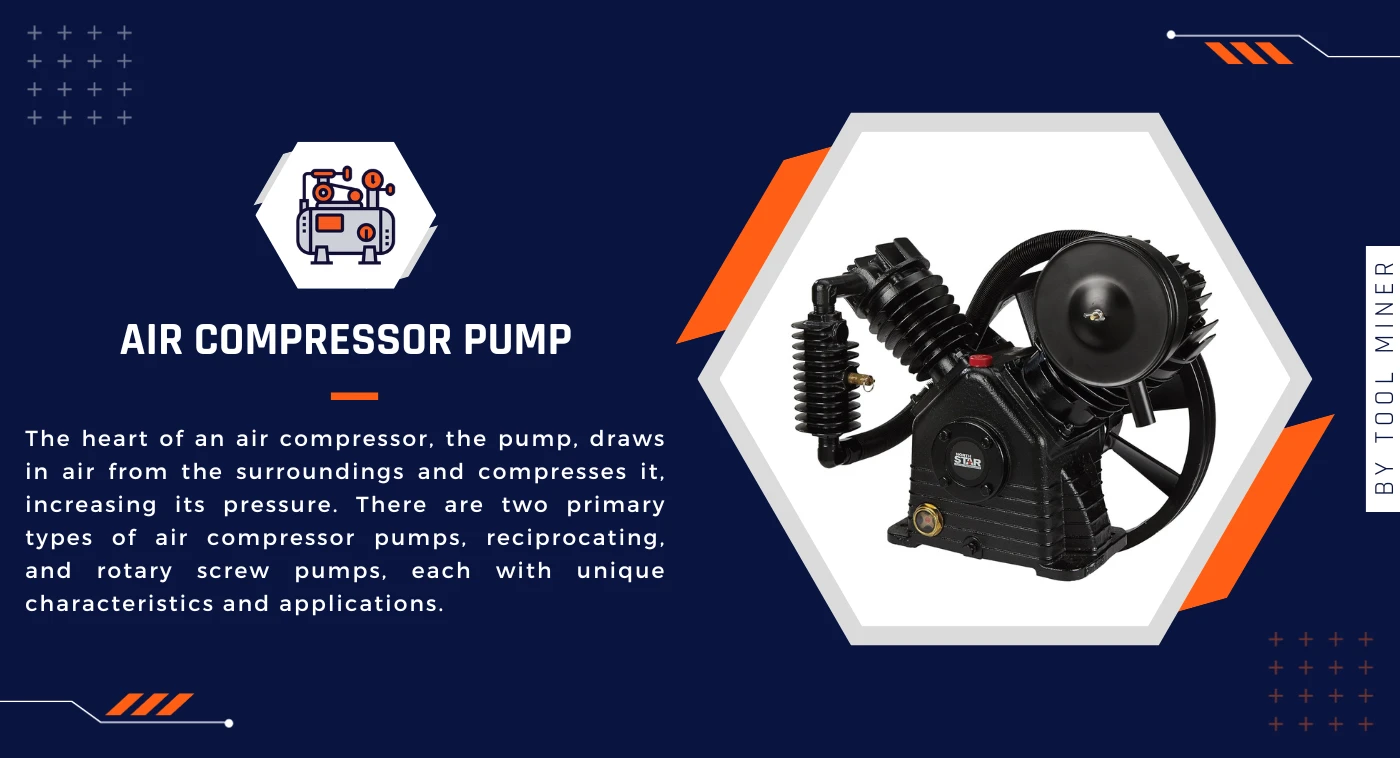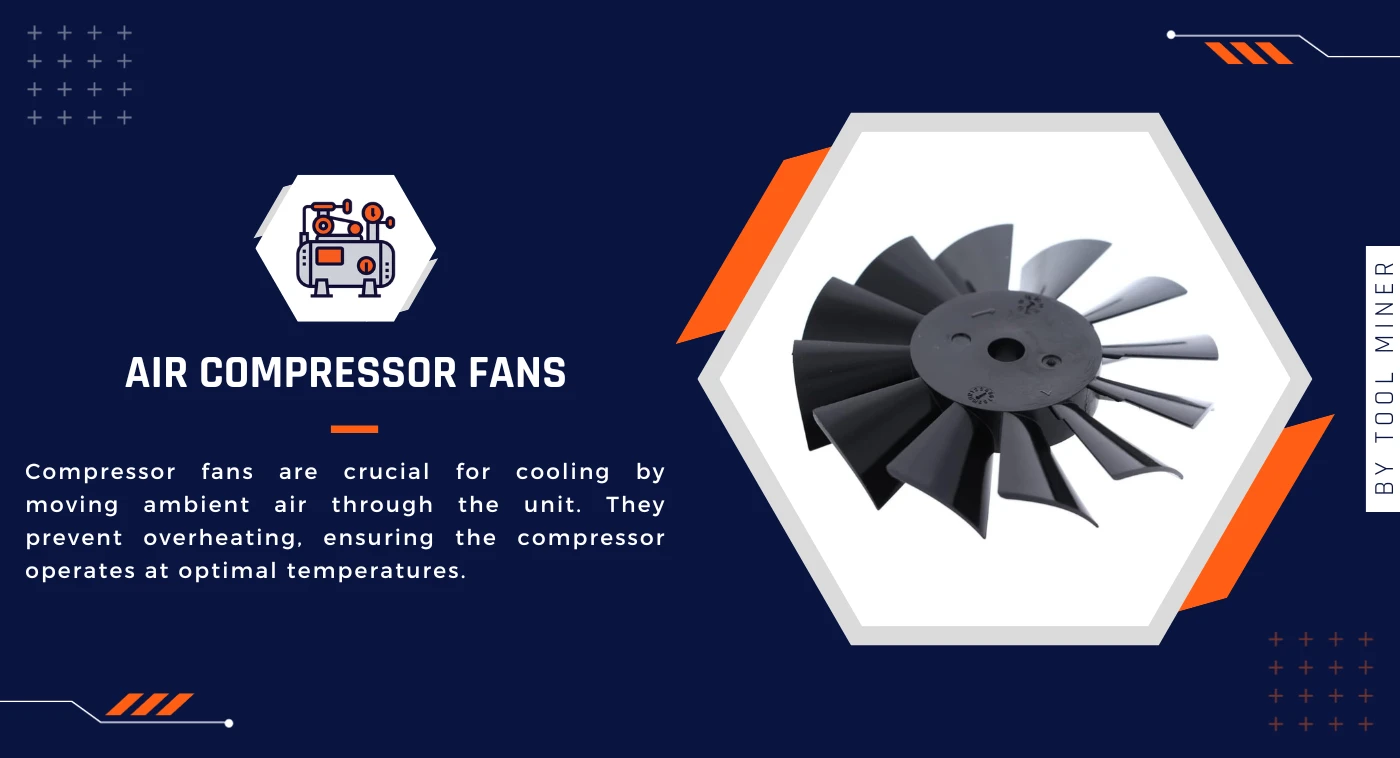Ultimate Guide to 15+ Main Parts of Air Compressor and Its Functions 2024
Hey Guys! Han here… Today I wanna share and uncover the fascinating bits that make air compressors tick. I remember spending hours fiddling with different parts of air compressor and learning the ins and outs firsthand.
One of the most interesting things I found was how they can power an array of air tools with just the simple concept of air pressure. But let’s get down to the nitty-gritty.
Why bother knowing these parts of air compressors, right? Well, it’s simple. “Imagine you’re on a project, and your compressor stops working.
If you know how these compressor components, you can troubleshoot issues, fine-tune performance, and ensure your compressor lives a long and efficient life.
So, in my guide, I’m going to take you through this exciting journey I’ve had – exploring the main parts of an air compressor including the motor, the pump, the tank, the regulator, filter, valves, pressure switch, Pistons, fans, O-Rings, Gaskets, etc.
You’ll gain insights that come from hands-on experience, maintenance tips that I’ve learned the hard way, and a deeper understanding of how these parts come together to create that wonderful gust of power.
Understanding Main Parts Of Air Compressor And Its Functions
Here, we will take an in-depth look at the main components and explore their functions and importance. Here is a complete air compressor parts list.
Air Compressor Parts List
- Air Compressor Motor
- Air Compressor Pump
- Air Compressor Tank
- Pressure Switch
- Pressure Gauge
- Air Compressor Air Filters
- Air Compressor Cooling System
- Desiccant Air Dryer
- Air Compressor Regulator
- Air Compressor Valves
- Air Compressor Pistons
- Other Air Compressor Parts
- Air Compressor Fans
- Air Compressor O Rings
- Air Compressor Pipes/Pipings
- Air Compressor Gasket
- Air Compressor Fittings/Couplers
10 Major Air Compressor Parts That You Shouldn’t Ignore
One thing I wanna highlight is that among these components there are 10 major air compressor parts that you should properly maintain and keep an eye on. Here I have made a table for you.
| No | Image | Parts | Function |
|---|---|---|---|
| 01 |
 |
Air Compressor Motor | The motor is responsible for powering the compressor. It provides the energy needed to compress air. |
| 02 |
 |
Air Compressor Pump | The pump is the heart of the compressor, responsible for drawing in and compressing air. |
| 03 |
 |
Air Compressor Storage Tank | The tank stores the compressed air, allowing for a consistent supply of pressurized air when needed. |
| 04 |
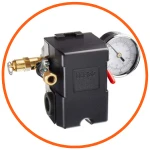 |
Air Compressor Pressure Switch | The pressure switch monitors the air pressure in the tank and turns the compressor on and off to maintain the desired pressure level. |
| 05 |
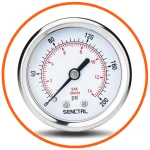 |
Air Compressor Gauges and Controls | These components include pressure gauges and control knobs that allow you to monitor and adjust the compressor's performance. |
| 06 |
 |
Air Compressor Filters | Air filters help remove dust, debris, and contaminants from the incoming air, improving the quality of the compressed air. |
| 07 |
 |
Air Compressor Pressure Regulators | These components help control and adjust the pressure of the compressed air as it leaves the tank, ensuring it matches the requirements of your tools or equipment. |
| 08 |
 |
Air Compressor Valves | Compressor valves, including intake and exhaust valves, control the flow of air in and out of the compressor's cylinders. |
| 09 |
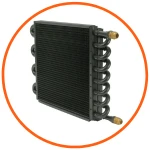 |
Air Compressor Cooling System | Many compressors have a cooling system, such as a fan or fins, to dissipate heat generated during compression. |
| 10 |
 |
Air Compressor Safety Relief Valve | This valve is a safety feature that releases excess pressure from the tank to prevent over-pressurization and potential hazards. |
What is an Air Compressor Motor?
The compressor motor is the real muscle behind your air compressor. It’s the one taking electricity and turning it into the power that gets your compressor humming.
Think of it as your compressor’s heart and soul. When you switch it on, the motor springs into action, converting that electrical energy into mechanical force.
This force drives the pump, pulling in air and compressing it – the essential steps for your compressor to work its magic.
But here’s the deal “Power Matters”. The motor’s horsepower (HP) determines how well your compressor performs. Need steady pressure? Match the right HP to your needs, and you’re golden.
Voltage and phase are part of the equation too. Voltage feeds the motor’s appetite, and phase is like its language. Get these right, and you’ve got a motor that speaks your compressor’s tune.
So, when you’re choosing an air compressor always consider the motor. Because the right motor is like picking the perfect partner for your projects.
What is an Air Compressor Pump?
Next up is the heart of an air compressor which is the “Air Compressor Pump”. It draws in air from the atmosphere and compresses it, increasing its pressure. There are two main types of air compressor pumps:
- Reciprocating pumps
- Rotary screw pumps
Reciprocating Pumps
Reciprocating pumps use pistons to compress the air. The piston moves downwards, drawing air into the cylinder. As it moves upwards, it compresses the air and pushes it into the tank.
Reciprocating pumps are known for their high-pressure output and versatility. They are suitable for a wide range of applications, from inflating tires to powering pneumatic tools.
Types Of Reciprocating Pumps
There are four types of reciprocating pumps
- Power pumps
- Air-operated pumps
- Power diaphragm pumps
- Air-operated piston pumps
Rotary Screw Pumps
Rotary screw pumps, on the other hand, use twin screws to compress the air. These screws rotate in opposite directions, trapping the air between them and reducing the volume. As the screws continue to rotate, the air is compressed and pushed into the tank.
Rotary screw pumps are known for their continuous operation, quiet operation, and high efficiency. They are often used in industrial settings where a constant supply of compressed air is required.
What is an Air Compressor Tank?
Now, let’s talk air compressor tanks – they’re the real MVPs in the world of air compressors. They act as a storage reservoir for the compressed air, allowing the compressor to build up pressure and store it for later use.
The tank capacity you choose depends on the specific applications you have in mind. A larger tank capacity means you can store more compressed air, which is beneficial for tasks that require a continuous supply of compressed air.
And I’ve gone down the rabbit hole just to explore these various sizes. From 6 gallons to a whopping 80 gallons, and trust me, it’s been quite the journey.
I did my homework, and in the 6-gallon compressors, the Porter Cable C2002 stole the show. It’s like the Goldilocks of pancake air compressors – just the right mix of portability and air-holding capacity.
Then there’s the 20-gallon squad, and the one that caught my eye was the WEN 2202T 15-Amp 20-gallon. It’s versatile, and cheaper which is a big plus in my book.
But as we move up the tank-size ladder – the 30-gallon, 60-gallon, and even the hefty 80-gallon beasts – it’s a whole new ballgame.
In the 30-gallon compressor category, the Industrial Air ILA1883054 flexed its power-size combo impressively. It is almost the same as the infamous DeWalt DXCMLA1983054 shop compressor.
And when it comes to the big guns, the 60-gallon and 80-gallon compressors, the Quincy QT-54 2V41C60VC and Campbell Hausfeld XC802100 showed they’re in a league of their own, nailing that high-performance air delivery.
For the nitty-gritty, check out my guides. They’re like treasure troves of tank wisdom, helping you navigate all things tank construction, pressure tricks, and more.
Remember, the right tank choice can level up your air compression game big time.
What is an Air Compressor Pressure Switch?
The air compressor pressure switch and pressure gauge work together to regulate the pressure inside the tank. It is responsible for automatically turning the compressor on and off as needed to maintain the desired pressure level.
It monitors the pressure inside the tank and activates the motor when the pressure drops below a certain threshold. Once the desired pressure is reached, the pressure switch turns off the motor.
My Air Compressor Experience
Let me tell you a small hidden problem regarding the pressure switch. If you don’t figure it out in the early stages then it becomes a real pain.
Most of the time the compressor stops working or causes functionality problems due to this little guy. So, if you think of repairing the air compressor yourself then all you have to do is to wire a new pressure switch.
But, if it’s beyond you then I suggest calling an expert from the air compressor services near you.
What Does an Air Pressure Gauge Do?
Now, let’s move on to the pressure gauge. It displays the current pressure inside the tank. It allows you to monitor the pressure at a glance and make adjustments if necessary.
It is important to keep an eye on the pressure gauge to ensure that the compressor is operating within the recommended pressure range.
What is Air Compressor Filter Used for?
Moving next on our air compressor parts list are the air compressor filters. They are responsible for removing impurities from the compressed air.
They ensure that the air is clean and free from contaminants, which is essential for the proper functioning of pneumatic tools and equipment.
Most air compressors have three types of filters
- Inlet Air Filter
- Oil Filter
- Oil/Water Separator
Inlet Air Filter
Air intake filters prevent dust, dirt, and other particles from entering the compressor and causing damage. They should be cleaned or replaced regularly to maintain optimal performance.
Oil Filter
Oil filters, on the other hand, remove oil and other contaminants from the compressed air. They are often used in oil-lubricated air compressors to ensure that the air is clean and free from oil particles.
Oil/Water Separator
The oil/water separators are one of the main parts of air compressor. They are small compared to other parts but their work is extremely important.
Because they help in extending compressor life by preventing oil and water contaminants from getting into the compressed air. They also prevent compressor problems like corrosion and air tool damage.
WHat is an Air Compressor Cooling System?
Aftercoolers are essential components in air compressor systems, designed to address two critical issues: cooling and dehumidifying compressed air.
As an expert in the field, I know that when air is discharged from an air compressor, it’s often at a high temperature, which can adversely affect equipment and carry moisture vapor that can lead to various problems.
Aftercoolers, in my experience, are invaluable solutions to these challenges by efficiently cooling the air and reducing its moisture content, ensuring it’s suitable for use in air-operated equipment.
understanding the two primary types of aftercoolers commonly used, air-cooled and water-cooled, is crucial for anyone involved in compressor systems.
Air-cooled aftercoolers use ambient air to cool the compressed air, while water-cooled aftercoolers are often the choice in stationary compressor installations, where cooling water is readily available.
Your decision between them, based on installation conditions and cooling requirements, can greatly impact system performance.
Overall, in my opinion, aftercoolers are indispensable for maintaining the quality and usability of compressed air in various industrial applications.
What is a Desiccant Air Dryer?
A desiccant is a special type of drying agent used for absorbing moisture from compressed air. They are in the form of beads like silica gel and activated alumina to absorb water vapors from air streams.
They are extremely vital for air compressors as they prevent the formation of moisture buildup, that causes corrosion. They also stop the water droplets from getting inside the attached air tools.
What Does an Air Compressor Regulator Do?
The air compressor regulator controls the output pressure of the compressed air. It allows you to adjust the pressure based on the requirements of the tools or equipment you’re using.
Because different pneumatic tools have different pressure requirements. I advise you to first know the CFM/PSI of the air tools you’re gonna use with your compressor.
Otherwise using the wrong pressure can lead to poor performance or damage. The regulator ensures that you don’t exceed the maximum pressure limit and allows you to optimize the performance of your tools.
How Do Air Compressor Valves Work?
Concerning air compressor valves there is a huge list coming right up for you. Different types of valves play different roles in the proper functioning of air compressors.
Such as allowing air in and out as you have seen above in “Piston Valves”, regulating airflow, draining water out, etc. They operate on the pressure difference and when a valve fails, it leads to the compressor system being overheated.
Below I have curated a list of 15+ air compressor valves that are found in different air compressor types.
Air Compressor Valves List
- Blowdown Valves
- Check Valves
- Control Valves
- Discharge Valves
- Drain Valves
- Inlet Valves
- Intake Valves
- Piston Valves
- Pneumatic Valves
- Pressure Relief Valves
- Purge Valves
- Regulator Valves
- Safety Valves
- Solenoid Valves
- Thermal Valves
- Thermostatic Valves
- Unloader Valves
- Water Regulator Valves
What Type of Air Compressor Uses Pistons?
These Pistons are used in reciprocating compressors also known as piston air compressors. They draw air through an inlet valve and then compress it and release it through an outlet valve.
In my “Air Compressor Parts” discussion earlier I said that there are compressor parts that are specific to a certain compressor type.
They are driven by a crankshaft with the help of a connecting rod. As the crankshaft rotates so do the pistons moves in upward and downward direction.
Now, it’s a bit complicated so I am making it simpler by giving you a brief introduction about the parts of reciprocating air compressor pistons.
Piston Rings
The piston rings are what you call the “Security Guard” that is attached to the piston as a seal. It prevents the air from leaking into the crankcase.
There are two types of piston rings:
- Compression Rings
- Oil Rings
Compression Rings
The first one is the compression rings which are located at the top of the piston. The purpose is to seal the combustion chamber.
Oil Rings
On the other hand, the oil rings are located at the bottom of the piston. The role is to prevent the oil from leaking into the cylinder. Since the reciprocating air compressors need oil.
What You Should Know! The reciprocating air compressors function optimally with SAE 30 or SAE 40 synthetic oils. While rotary screw compressors work best with ISO 32 and ISO 46 compressor oils.
Piston Rods
The piston rods as you know are the long connecting rods. They connect the crankshaft and the pistons to each other and move back and forth to compress air.
Piston Valves
Piston valves are the ones responsible for letting the air in and out of the chamber. The first is the Inlet Valve which opens when the piston moves down to let the air in.
The second one is the outlet valve that forces the compressed air out of the chamber as the piston gradually moves up.
Other Air Compressor Parts
Besides the main parts, other air compressor parts are also vital. Let’s begin with these small guys.
What is an Air Compressor Fan Used for?
The air compressor fan is one of the key players responsible for cooling the compressor off. It directly takes the atmospheric air and moves it to the compression chamber.
The fan continuously moves cooling air throughout the compressor parts to dissipate the heat. When the air is compressed, it gradually becomes hot. If the fan doesn’t maintain cooling the compressor gets overheated or in the worst cases catches fire.
What is the Purpose of an O-Ring?
An air compressor o-ring is a circular-shaped seal that is present around the rotating shafts. They prevent air leakage from these parts.
If the o-ring is not effectively sealing it reduces the compressor efficiency and over time can damage the compressor slowly.
For example, you know about the compression rings and oil rings that I talked with you about a few minutes ago in the “Piston Rings” section.
There are mainly two types of O-rings in air compressors:
Static O-rings
The static O-rings are used to seal the stationary parts of air compressor. Such as the air inlet and outlet valves/ports.
Dynamic O-rings
On the other hand, the dynamic O-rings are utilized for sealing up the moving compressor parts. Such as the piston and crankshaft.
Air Compressor Pipes/Pipings
The compressor pipes are what you call the drivers that carry air from one part to another compressor part. They are made of various materials i.e., copper, steel, rubber, and plastic.
Also, I want you to know that there is a bit of a size difference between the piping inside a compressor. Let me give you an example, the piping closer to an inlet, is bigger to draw a large amount of air in.
On the flip side, the pipes closer to the outlet valve are considerably smaller because they need to throw air into a small pressurized stream.
What is An Air Compressor Gasket?
Air compressor gaskets are what you call a barrier between two metal surfaces or compressor parts. They are made of different kinds of materials such as silicone, cork, neoprene, and rubber.
As a seal, it completely blocks any nook or cranny between the metal parts. So, the air can be properly compressed within the chamber and won’t leak out.
For it to work properly, the seal must be soft and at the same time firm enough to stay in place. That’s why I always recommend rubber gaskets whenever people come to our garage for advice.
Because they can seal up efficiently at lower temperatures and pressure conditions. They are flexible enough, easy to install, and are cheap compared to other gaskets. Plus, they have good resistance against chemicals and oils.
Here is a list of air compressor parts that have gaskets:
- Head gasket
- Cylinder gasket
- Valve plate gasket
Air Compressor Fittings/Couplers
The air compressor fittings or couplers are used to attach tubes, pipes, and hoses or to other air tools. They are also used for connecting extra air tanks to increase storage capacity.
Now, you should know that there are different types of air fittings. But, in my experience, most of the air tools used with air compressors use one type of connector.
Types of Air Fittings
Here is a list of most common types of air fittings:
- 3/8” NPT Fitting
- 1/4” PCL Fitting
- 1/4” BSP Fitting
Air Compressor Attachments And Accessories
The Next thing I wanna shed light on is the various air compressor tools and attachments you use. These attachments no doubt are connected with the air compressor by using the above-mentioned air fittings.
List Of Air Compressor Tools And Attachments
Below are the most common air tools used by professionals in various industries. Here is a complete list of air compressor tools with their CFM, PSI, and the work they’re used for.
Most of them I use are paint sprayers, nailers, staplers, and impact wrenches. Below, I have grouped the tools based on their primary functions and applications.
| No | Tools | CFM Requirement | PSI Requirement | Common Applications |
|---|---|---|---|---|
| 01 | Air Impact Wrench | 4 to 6 CFM | @ 90 - 100 PSI | Automotive, Construction |
| 02 | Air Ratchet | 2 to 4 CFM | @ 70 - 90 PSI | Automotive, Mechanics |
| 03 | Air Nail Gun | 2 to 5 CFM | @ 70 - 90 PSI | Carpentry, Framing |
| 04 | Air Stapler | 2 to 5 CFM | @ 70 - 90 PSI | Upholstery, Woodworking |
| 05 | Air Impact Driver | 4 to 6 CFM | @ 90 - 100 PSI | Automotive, Assembly |
| 06 | Air Drill | 3 to 6 CFM | @ 90 - 100 PSI | Metalworking, Woodworking |
| 07 | Air Grinder | 5 to 8 CFM | @ 90 - 100 PSI | Metalworking, Welding |
| 08 | Air Sander | 8 to 10 CFM | @ 90 - 100 PSI | Automotive, Woodworking |
| 09 | Air Hammer | 4 to 9 CFM | @ 90 - 100 PSI | Metalworking, Concrete |
| 10 | Air Die Grinder | 4 to 6 CFM | @ 90 - 100 PSI | Metalworking, Grinding |
| 11 | Air Chisel | 3 to 6 CFM | @ 90 - 100 PSI | Automotive, Construction |
| 12 | Air Spray Gun | 7 to 12 CFM | @ 30 - 50 PSI | Automotive Refinishing, Painting |
| 13 | Air Grease Gun | 3 to 6 CFM | @ 90 - 100 PSI | Automotive, Machinery |
| 14 | Air Blow Gun | 2 to 4 CFM | @ 90 - 100 PSI | Cleaning, Dusting |
| 15 | Air Tire Inflator | 2 to 4 CFM | @ 30 - 50 PSI | Tire Inflation, Automotive |
| 16 | Airbrush | 0.1 to 0.5 CFM | @ 20 - 30 PSI | Art, Illustration |
| 17 | Air Speed Saw | 5 to 8 CFM | @ 90 - 100 PSI | Metalworking, Woodworking |
| 18 | Air Nibblers | 4 to 6 CFM | @ 90 - 100 PSI | Metal Cutting, Roofing |
| 19 | Air Shear | 4 to 6 CFM | @ 90 - 100 PSI | Metal Shearing, Fabrication |
| 20 | Air Riveter | 3 to 5 CFM | @ 90 - 100 PSI | Automotive, Metalworking |
Remember! These are general requirements; always check the specific tool’s manual for precise specifications as they vary by brand and model.
Air Compressor Accessories
Now these will be the last things that you usually use with your compressors. Air compressor accessories are necessary to accommodate and make your smoother.
I have created a short table of air compressor accessories that you’ll need in your work.
| No | Accessories | Description |
|---|---|---|
| 01 | Vibration Pads | Placed under the compressor to reduce vibration and noise. They come in various sizes |
| 02 | Mufflers or Silencers | Reduce noise generated by the air compressor, making it quieter during operation. |
| 03 | Air Compressor Hoses | Used to connect air tools to the compressor. |
| 04 | Air Compressor Hose Reels | Mechanisms for neatly storing and retracting air compressor hoses to prevent tangling and damage. |
| 05 | Air Compressor Synthetic Oils | Specially formulated synthetic oils designed for use in air compressors to ensure efficient lubrication and performance. |
I have used many of them such as the vibration pads, and mufflers for reducing compressor noise.
The air compressor synthetic oils are not too far. As they are important if you’re working with oil-lubricated air compressors. They are way better in performance compared to ordinary compressor oils.
On the other hand, the air hoses are used for direct airflow to power air tools. These are specially designed for compressors to withstand high pressure.
They come in various sizes depending on your demand. I recommend using hose reels because they are longer compared to hoses.
Maintenance And Troubleshooting Tips For Air Compressor Parts
After discussing all the parts that I know of… I wanna highlight the importance of maintenance of these compressor parts.
You need to create an air compressor maintenance schedule to avoid costly mistakes of compressor damage, faults, or even death.
Air Compressor Maintenance Tips
Proper maintenance is essential to keep your air compressor in good working condition and extend its lifespan. Here are some compressor maintenance tips to keep in mind:
- Regularly check and change the air filters to ensure that the air is clean and free from contaminants.
- Drain the condensation from the air compressor tank to prevent moisture buildup.
- Check the belts, hoses, and fittings for signs of wear and tear and replace them if necessary.
- Lubricate the moving parts of the compressor as recommended by the manufacturer.
- Keep the compressor clean and free from dust and debris.
Air Compressor Troubleshooting Tips
In addition to regular maintenance, it’s important to be familiar with common troubleshooting techniques. Here are some common issues you may encounter with your air compressor and how to troubleshoot them:
- Low Pressure: Check the pressure switch, pressure gauge, and regulator settings. Adjust them if necessary.
- Excessive Noise: Inspect the motor, pump, and other components for loose or worn-out parts. Tighten or replace them as needed.
- Air Leaks: Check the fittings, hoses, and connections for leaks. Tighten or replace them if necessary.
- Overheating: Ensure that the compressor is properly ventilated and not operating in a hot environment. Check the motor and pump for signs of overheating and address the issue promptly.
By following these maintenance and troubleshooting tips, you can keep your air compressor running smoothly and avoid costly repairs.
The bottom line is that understanding these parts of air compressor is crucial for maximizing its potential and ensuring optimal performance.
Air Compressor Parts FAQs
Why Do We Need an Air Compressor?
Air compressors are essential for various applications across industries. They provide a source of compressed air that powers pneumatic tools and equipment. This compressed air is used for tasks such as inflating tires, operating power tools, painting, sanding, cleaning, and more.
Is the Air Compressor Part of the Engine?
The air compressor is not typically part of the engine itself. It is a separate device used to compress air for various applications. It can be powered by an electric motor or a gas engine, and its compressed air is often used to operate pneumatic tools and equipment.
What Are the Components of an Air Compressor?
The key components include the motor, pump, tank, pressure switch, pressure gauge, air filters, cooling system, desiccant air dryer, regulator, valves, pistons, and various other parts such as fans, O-rings, pipes/pipings, gaskets, fittings/couplers.
How Air Compressor Pump Works?
An air compressor pump operates by drawing in atmospheric air and then compressing it. This compression is achieved through the movement of pistons or screws within the pump. As the air is compressed, its volume decreases, and its pressure increases. The compressed air is then stored in the tank for later use.
When to Replace Air Compressor Tank?
The compressor tank replacement depends on the tank condition and severity of rust or corrosion. Generally, the rotary compressor tanks last up to 30 years. While the reciprocating compressor tank lasts up to 15 years.
Are Air Compressor Parts Interchangeable?
Whether air compressor parts are interchangeable depends on the specific make and model of the compressor. Brands Rolair, Ingersoll Rand, Campbell Hausfeld, and various other brands parts i.e., filters and check valves are interchangeable.
Where to Buy Air Compressor Parts?
You can buy air compressor parts from various sources, including:
Manufacturer’s Website: Some manufacturers sell replacement parts directly through their websites.
Online Retailers: Many online retailers such as Amazon, Walmart, Acme Tools, Tool Barn specialize in air compressor parts and offer a wide selection.
Authorized Dealers: Contact the manufacturer’s authorized dealers or distributors for genuine replacement parts.
Other Sources: Local Hardware Stores, Industrial Supply Stores, and Specialty Parts Suppliers.



